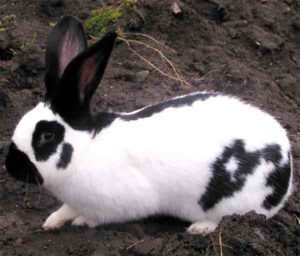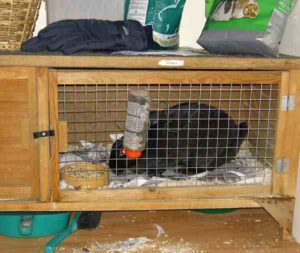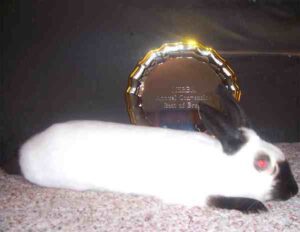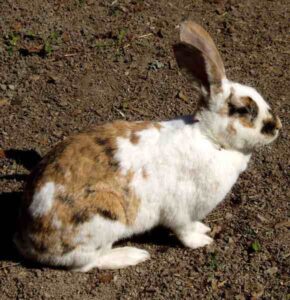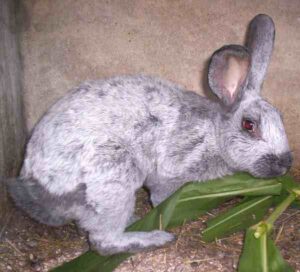The Beveren rabbit is one of the oldest and largest breed of fur rabbit. They were mainly developed for their fur. Beveren rabbits originated unsurprisingly in Beveren around the year of 1898. Beveren is a small town near Antwerp in Belgium.
The original color of the Beveren rabbit was a blue that mostly came about through selection of the self blue St. Nicholas (St. Niklass). And the early Blue Beverens showed varying depth of color. But a light lavender-blue was the preferred color by the furriers.
The Blue Beverens were first imported into the United Kingdom by Mrs. A.M. Martin. And the Blue Beverens were first showed at Norwich in 1905. Then the breed quickly become most popular fur rabbit breed in the United Kingdom.
The Beveren rabbit arrived in the United States around 1915 and it was listed in the Standard under the spelling of ‘Beverin’. The breed is recognized by both the American Rabbit Breeders Association and the British Rabbit Council.
Currently the Beverens are suffering from lack of popularity. But still many breeders in Belgium and some other countries continue to breed them. The American Livestock Breeds Conservancy places the Beveren rabbits on the ‘Watch’ list. Today the breed is kept mainly for their fur and meat.
Physical Characteristics of Beveren Rabbit
The Beveren rabbit is a large breed with mandolin shape body type. Their body is medium in length with broad, meaty back and a deep, firm loin. The shoulders of the Beveren rabbits are strong and firm with a well-sprung rib cage, tapering slightly from broader, smooth hips.
When viewed from the side, a definite arch is present in the body. The topline is a smooth curve, starting at the back of the shoulder, rising to a high point over the middle of the back, and curving over the hips to complete the arch.
Head of the Beveren rabbit is full from top to bottom, with a well filled face and jaws. Their ears are well furred and carried upright in a V shaped manner. Their front feet and legs are straight, strong and of medium bone. And the hind feet and legs are powerful, straight and well furred.
In proportion to size of body, the legs of the Beveren rabbit are of medium bone. Their coat is very dense and glossy. The guard hairs are plentiful and of fine diameter, but strong enough to fall or roll gently back into position when stroked from tail to head.
Fur length is rather long having an average of 1¼ to 1½ inches. The color of their coat can be Black, Blue, Brown, Lilac and White. But all of these color varieties are not recognized by the American Rabbit Breeders Association. The Blue variety is the original Beverens.
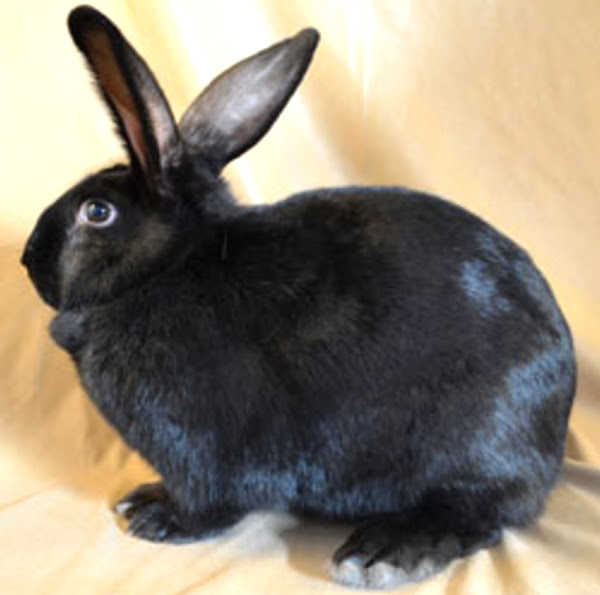
American Rabbit Breeders Association recognizes Black, Blue and White variety of Beveren rabbit. It is a big sized rabbit and it’s body weight is classified into four grades ; pre-junior, junior, intermediate, and senior.
Each grade of bucks and does will have a different body weight, which can be from 2 kg to up to 6 kg. Photo from The Livestock Conservancy.
Uses
Beveren rabbits were mainly created as a fur producing animal. And they are also good for meat production. They can also be kept as pets and show animals.
Special Notes
The Beveren rabbit is docile and gentle in nature. The does are usually larger than the bucks, like most other rabbit breeds. Their litters are large and the does are typically docile and make excellent mothers. The young grow relatively fast.
The Beveren rabbit is certainly a multi purpose breed of rabbits used for both meat and fur production. It is a very hardy breed and it can be easily reared in all wire hutches. They are very good for cold climates. Like most other rabbit breeds, they also feel comfortable and live happy life if living in groups.
Average lifespan of the Beveren rabbit is about 5 to 8 years or even more in captivity. However, review their full breed profile in the following chart.
| Breed Name | Beveren |
| Other Name | Beverin, Giant Beveren, Blue Rabbit of Beveren |
| Breed Purpose | Meat & Fur. Also good as pets and show animals. |
| Breed Size | Large |
| Weight | Body weight of Beveren rabbit is classified into four grades ; pre-junior, junior, intermediate, and senior. Each grade of bucks and does will have a different body weight, which can be from 2 kg to up to 6 kg. |
| Suitable for Commercial Production | Yes |
| Good as Pets | Yes |
| Climate Tolerance | All Climates (Extremely cold hardy breed) |
| Color Varieties | Black, Blue, White |
| Rarity | Common |
| Country of Origin | Belgium |
